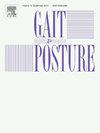Gait of lower limb amputees: Unusual time-course of vertical ground reaction forces of the intact limb
IF 2.2
3区 医学
Q3 NEUROSCIENCES
引用次数: 0
Abstract
Background
The impact of an amputation on the intact limb during walking is still unclear. By using vertical ground reaction forces (vGRF), recent reports suggested that not all amputees exhibit the classical M-shape. However, there is no study exploring these “Non-M” strides on both feet. The purpose of present study was to explore the vGRF time-course during gait and to quantify “Non-M” strides, their reproducibility and factors that could influence their apparition.
Methods
vGRF of 29 controls and 23 unilateral lower-limb amputees were recorded during a 5-min walk at comfortable speed on an instrumented treadmill. Each stride was classified as “M” or “Non-M” to determine the percentage of “Non-M” strides per limb that were then compared between groups and limbs. The influence of age, time since amputation, speed, stance phase ASI, and type of prosthetic foot on the percentage of “Non-M” strides was tested. Comparisons between intact and prosthetic sides were made for duration of the stance phase and variability of vGRF patterns.
Results
the percentage of “Non-M” strides was higher in the amputee group (p < 0.001) and higher in the intact limb compared to the prosthetic limb (p < 0.001). The analysis of the variables that could influence vGRF did not identify a cause. The amputees who also produced “Non-M” strides had higher variability in their vGRF patterns on the intact limb compared to those producing only “M” strides. This was not observed on the prosthetic side.
Significance
The results suggest that the intact limb adapts in real-time to manage the body's movements, compensating for limits of prosthetic footwear. The global time-course of the vGRF (rather than the first peak) is a useful tool for studying the impact of the prosthesis on the intact limb.
求助全文
约1分钟内获得全文
求助全文
来源期刊

Gait & posture
医学-神经科学
CiteScore
4.70
自引率
12.50%
发文量
616
审稿时长
6 months
期刊介绍:
Gait & Posture is a vehicle for the publication of up-to-date basic and clinical research on all aspects of locomotion and balance.
The topics covered include: Techniques for the measurement of gait and posture, and the standardization of results presentation; Studies of normal and pathological gait; Treatment of gait and postural abnormalities; Biomechanical and theoretical approaches to gait and posture; Mathematical models of joint and muscle mechanics; Neurological and musculoskeletal function in gait and posture; The evolution of upright posture and bipedal locomotion; Adaptations of carrying loads, walking on uneven surfaces, climbing stairs etc; spinal biomechanics only if they are directly related to gait and/or posture and are of general interest to our readers; The effect of aging and development on gait and posture; Psychological and cultural aspects of gait; Patient education.
 求助内容:
求助内容: 应助结果提醒方式:
应助结果提醒方式:


